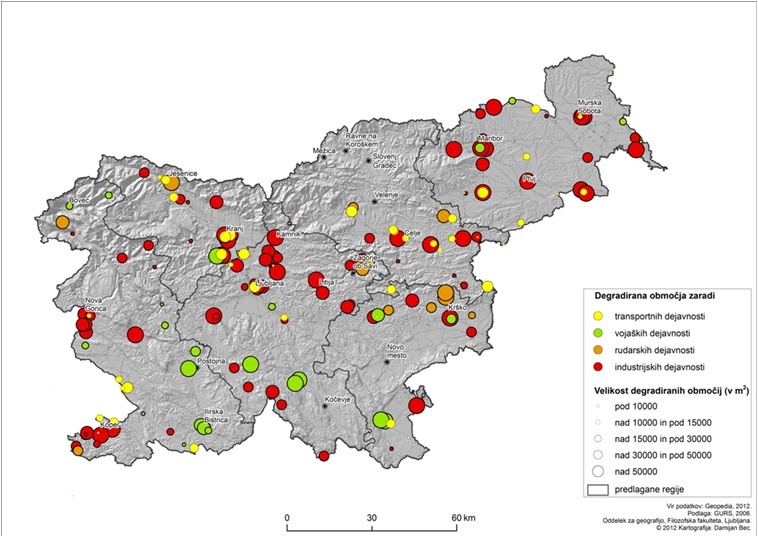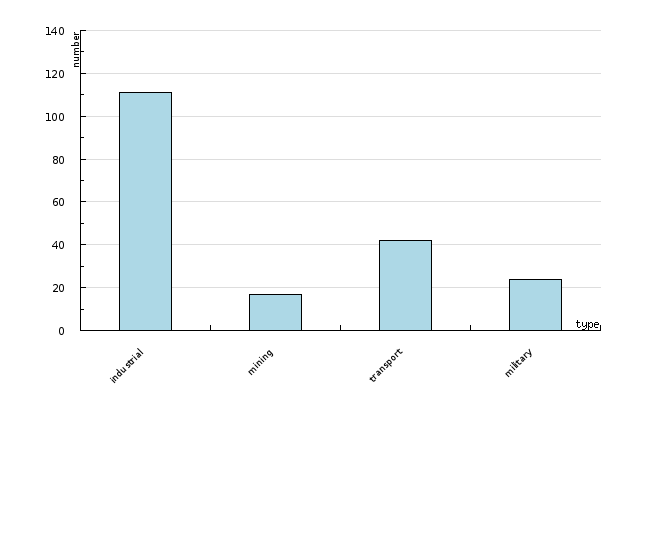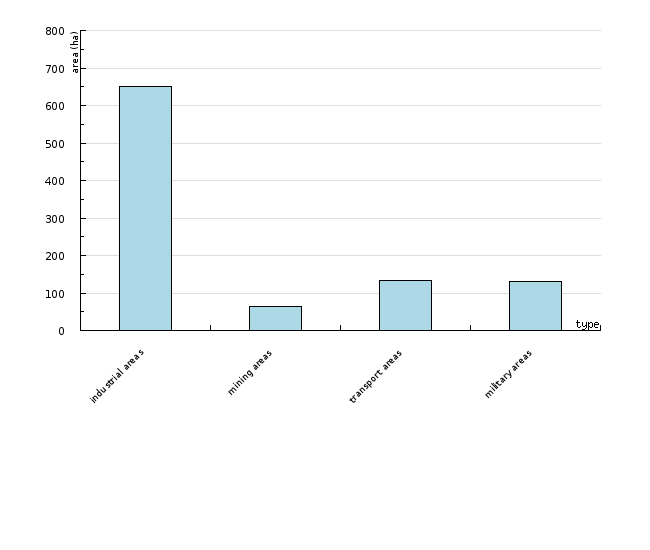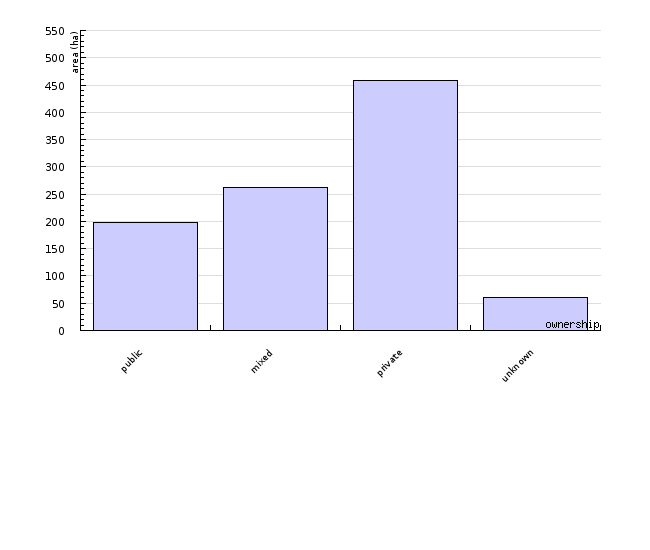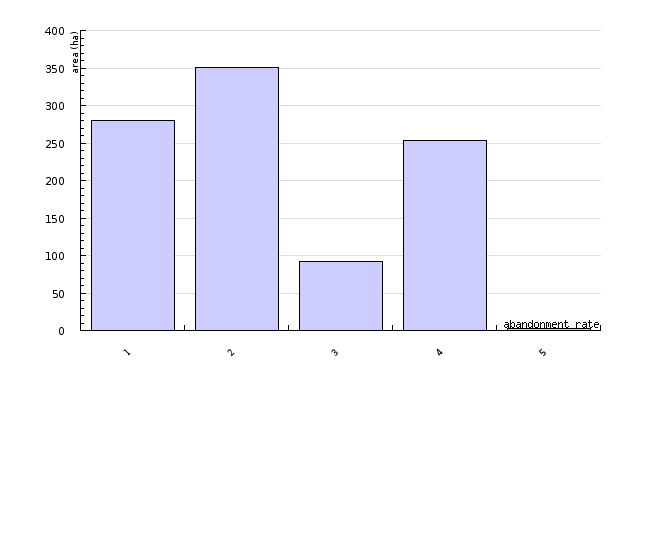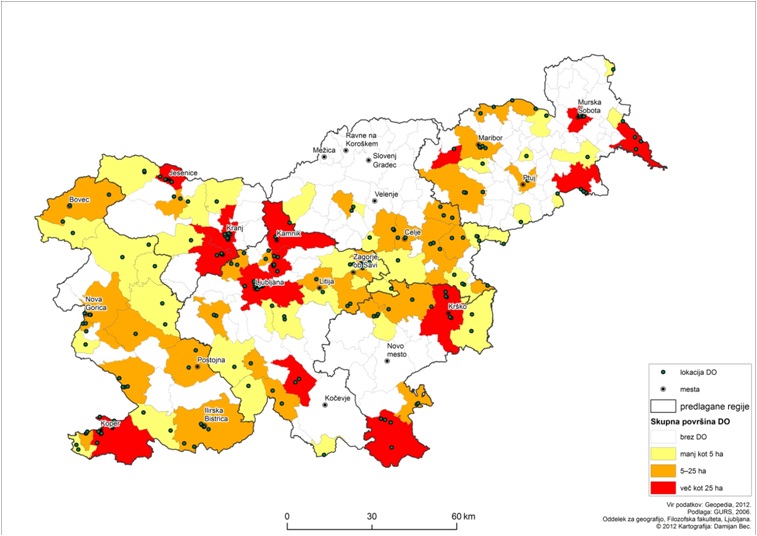[TP02] Brownfield sites

Key message

In 2011, 194 brownfield sites with a total area of 979 hectares were recorded in Slovenia. Included in the record were areas in which degradation had been caused by industry, military activities, transport, infrastructure and mining.
Alongside the goal of reducing the total area of brownfield sites and environmentally remediating the most problematic sites, the key objective in the management of brownfield sites is to set up an integrated database on the basis of which various sectors will be able to carry out their activities in line with sustainable spatial management principles.
Definition
This indicator shows the number, size and type of brownfield sites in Slovenia in 2011 resulting from abandonment of activities and changed functions of land (devaluation). Brownfield sites include all areas where activities that caused degradation are:
a) entirely abandoned,
b) mostly abandoned but present in part of the area,
c) abandoned, while a new activity takes place in part of the degraded area, or
d) old and new activities take place in various parts of the area.
The areas in which degradation was caused by industry, military activities, mining (surface degradation), transport and infrastructure are included. All areas larger than 1 ha (10,000 m2) and a few slightly smaller areas are included.
Charts
Oddelek za geografijo, Filozofska fakulteta Univerze Ljubljani, Evidenca degradiranih površin, 2011
Oddelek za geografijo, Filozofska fakulteta Univerze Ljubljani, Evidenca degradiranih površin, 2011
| type | 2011 | |
|---|---|---|
| industrial | number | 111 |
| mining | number | 17 |
| transport | number | 42 |
| military | number | 24 |
| total | number | 194 |
Oddelek za geografijo, Filozofska fakulteta Univerze Ljubljani, Evidenca degradiranih površin, 2011
| type | 2011 | |
|---|---|---|
| industrial areas | ha | 651.366694099 |
| mining areas | ha | 64.5200856946 |
| transport areas | ha | 132.832181909 |
| military areas | ha | 130.292788437 |
| total | ha | 979.01175014 |
Oddelek za geografijo, Filozofska fakulteta Univerze Ljubljani, Evidenca degradiranih površin, 2011
| ownership | public | mixed | private | unknown | |
|---|---|---|---|---|---|
| brownfield area | ha | 198.436869711 | 262.325544167 | 457.687923763 | 60.5614125 |
| brownfield sites | število | 32 | 48 | 100 | 14 |
Oddelek za geografijo, Filozofska fakulteta Univerze Ljubljani, Evidenca degradiranih površin, 2011
Oddelek za geografijo, Filozofska fakulteta Univerze Ljubljani, Evidenca degradiranih površin, 2011
Goals
- Remediation of brownfield sites (National Environmental Action Programme);
- Rational use of land and revitalisation of degraded urban areas (Spatial Management Policy of the Republic of Slovenia);
- Revitalisation of degraded urban areas and redevelopment of old industrial and mining areas/towns. (Spatial Development Strategy of Slovenia)
Meeting these goals would require:
• Reducing the size and number of brownfield sites;
• Remediation of the most environmentally problematic areas and thus reduction of human health hazards;
• Improvement of the quality of living of people living in environmentally degraded areas;
• Setting up an active (regularly updated), integrated register of brownfield sites in Slovenia and making the data available to all relevant sectors;
• More efficient brownfield site management, more rational land use with the priority of directing planned activities to already degraded areas, thus preserving agricultural land;
• Providing clear guidelines and setting out the conditions of land use with regard to brownfield site types;
Comment
The analysis of brownfield sites in Slovenia that are a result of abandonment of activities (hereinafter: BF sites) and surveyed according to pre-set criteria, reflects the situation in Slovenia in the spring of 2011. This is the first spatial and data record of brownfield sites in Slovenia, which will need to be regularly updated and upgraded, as the situation may change quickly. Nevertheless, the acquired data represent the basis for addressing the BF sites issue in the future in the field of spatial planning as well as from the development perspective at the national, regional as well as local levels. Here, the State will play a crucial role: it will have to integrate BF sites into all basic development documents (at all spatial levels) and prepare clear guidelines as regards the possibilities and conditions of use by different BF site types.
According to the criteria used to carry out the BF site survey, the areas were categorised into four groups – industrial areas, mining areas, transport and other infrastructure areas and structures and military areas. As expected, the greatest number of BF sites falls within the first category – industrial areas, which are the most common in central Slovenia and old industrial centres in other Slovenian regions.
In total, 194 BF sites were listed with the total surface area of 979 hectares. BF sites are present in 82 municipalities. The largest BF sites is located in the Lendava municipality – the site of the Lendava oil refinery (Rafinerija nafte Lendava) (72 ha). The greatest number of BF sites are found in the Central Slovenia Statistical Region (32), followed by the Savinjska (26) and Gorenjska (22) regions. In the Koroška Statistical Region, no BF sites that would comply with the selected criteria were identified. In the Zasavje region, regardless of its small size, 9 BF sites were identified. In terms of surface area, BF sites occupy the largest total area in the Podravje and Central Slovenia regions, while they occupy the smallest area in the Zasavje, Goriška and Notranjska-Kras regions.
As this indicator is based on the data that were acquired for the territory of Slovenia for the first time, no spatial development trend can be presented for this phenomenon.
49 BF sites larger than 5 ha were identified, of which 28 are industrial areas. The number of BF sites larger than 10 ha is 20. 29 areas with the surface area of 0.6–1 ha were also included in the survey, due to them being, according to our estimate, sufficiently relevant for inclusion in the records.
Ownership is the greatest obstacle in BF site management at the local/regional level as well as in planning and further placement of new activities and remediation of the sites. Over the last twenty years, most recently identified BF sites have come under private ownership and only a few are publicly owned.
As the lack of land for the expansion of activities has been pointed out as a general problem in Slovenia, the extent to which the identified BF sites are abandoned is important. All of the identified BF sites are at least partially abandoned, but great differences between them exist. 81 BF sites are entirely abandoned (with a total area of 254 ha). At most BF sites, the primary activity has been partially abandoned, but is still present in part of the site (total area of 351 ha). The analysis of ownership and the level of abandonment showed that most entirely abandoned BF sites are privately owned, which additionally confirms the fact that the current ownership is one of the greatest obstacles in addressing the issue of BF sites, which is very complex. The existing records do not include all the brownfield sites that are a result of the abandonment of activities, as we intentionally left out e.g. degraded residential areas, agricultural areas (e.g. former large-scale farms with associated land), etc. on request by the Ministry of Economic Development and Technology, which ordered the survey. According to our findings, there are even more areas that would be suitable for expansion of activities and that should undoubtedly be given priority in locating new development projects and activities. According to the existing situation, it would be necessary (and feasible) to completely stop development on agricultural land and direct all activities to the existing degraded areas, i.e. brownfield sites.









